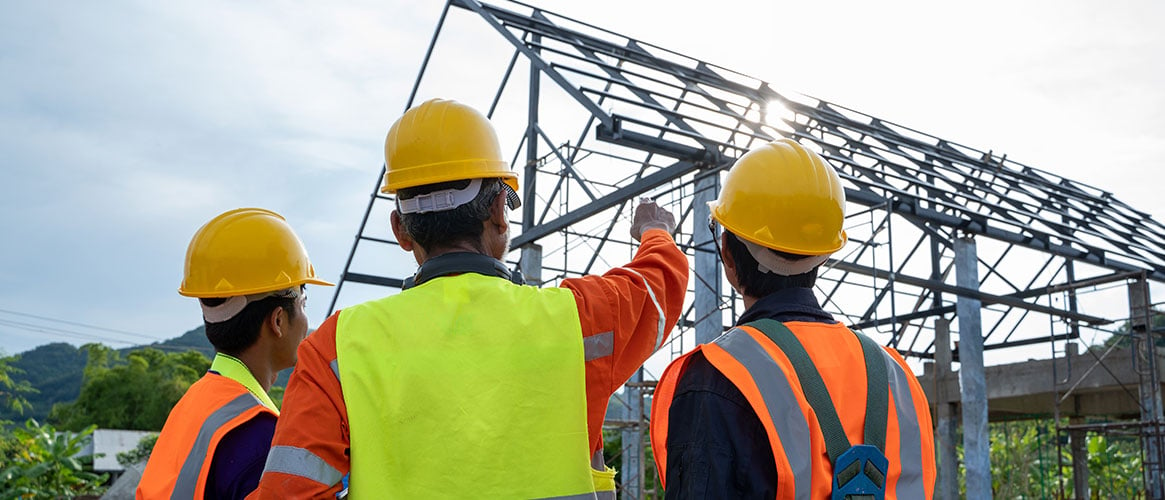2. Lead by example
You may have heard the phrase “if you talk the talk, you must walk the walk.” For small businesses, make sure you understand what’s in your IIPP and follow it. For larger organizations, you might need to get your leadership team together to review the IIPP and make sure everyone understands it and agrees to follow it.
The last thing you want is for your employees to see you violating the safety processes you and they worked so hard to put in place. First, that can damage morale. Second, you’d be sending a message that rules aren’t important. This could lead to more injuries, illnesses, claims, and costs for your business. So, if you need to enter an area where hard hats are required, make sure to wear the hard hat even if you’ll be there for only a few minutes.
3. Clearly define responsibilities and accountability for supervisors
Supervisors, including the foreperson and site leads, have key responsibilities for every element of the IIPP. This includes providing proper training so employees know how to do the job safely.
If supervisors don’t monitor for compliance with safe work practices and correct unsafe behavior when they observe it, employees will start to ignore the safety rules put in place for their protection. If supervisors don’t encourage two-way communication during safety meetings, employees won’t feel their input is appreciated or valued and they will stop caring about the success of the program. If supervisors prioritize production goals and meeting deadlines over doing the job safely, then employees can get hurt.
To employees, supervisors are the most visible reflection of the safety culture within your organization. Just like it is for upper management, remind your supervisors also to lead by example.
4. Investigate all accidents and near-miss incidents
One of the best predictors of a future workplace injury is one that has already happened or one that almost happened (near miss). Thoroughly investigate all workplace accidents and near misses and involve your employees too. They can provide a unique perspective as to why something happened, especially if they witnessed the accident. Our Accident Investigation Packet can help you document your findings.
The accident/near miss investigation is a critical part of your IIPP that is often neglected. This investigation should always dig down to the “root cause or causes” of the accident or near miss. Sure, an employee might have taken a shortcut to get the job done. But, there may also have been a malfunction in a piece of equipment that wasn’t caught, or a safety precaution that wasn't in place yet. What you learn in your investigation may prevent a future occurrence of the same injury. By investigating near misses, you might even identify a hazard and make changes before someone gets hurt.
Remember also to conduct your investigation as soon as possible after an accident or near miss. This way, it’s fresh in the minds of your coworkers and anyone else who may have witnessed the incident. If you wait too long, workers may forget important details or accounts of what happened may change.
5. Document and keep everything
Recordkeeping is a critical part of your safety plan. Any time there is an accident or near miss, you need to establish records of what happened. This includes:
- What the investigation revealed
- Corrective actions
- Disciplinary actions
- Training recommendations or changes
You can use the records of any accident or identification of a new hazard to update your policies and procedures as well as your IIPP. And, you can incorporate these matters into new hire training so that the next generation of employees at your workplace can also learn them, even though they weren’t around at the time an incident occurred. You can also reference the past while training your employees on how to perform tasks the right and safe way from the start.
In addition to keeping records of any accident or near miss, you should also keep ongoing records of the safety measures you implement. For example, keep all documents you use during your workplace safety inspections. This way you can refer back to past assessments of your workplace and what actions you took to identify hazards.
Other important records to keep include:
- Training – who is trained, what subjects were covered, and how it complies with the training requirements of your IIPP
- Injuries and illnesses at your workplace – this helps you identify negative trends that you can address with your employees and supervisors
6. Review and update your IIPP
According to Cal/OSHA, a regular review and updating your IIPP is how you keep it effective. One best practice is to review it at least once per year and anytime you discover new hazards in the workplace.
This process allows you to double and triple check to ensure employees are still following your procedures. And, you can verify that corrective actions put in place after previous investigations are still there. Check to see if there are any new processes, jobsites, or company functions that are not yet reflected in the current program.
Having an IIPP that meets Cal/OSHA regulations puts you in compliance with the state and helps you avoid citations. Having a successful IIPP helps you take workplace safety to the next level, where employees are involved in establishing and maintaining a safe workplace. When employees take a lead role in important matters like workplace safety, other members of the staff will follow their lead.
Follow these 6 steps for a successful IIPP that also helps your bottom line!
